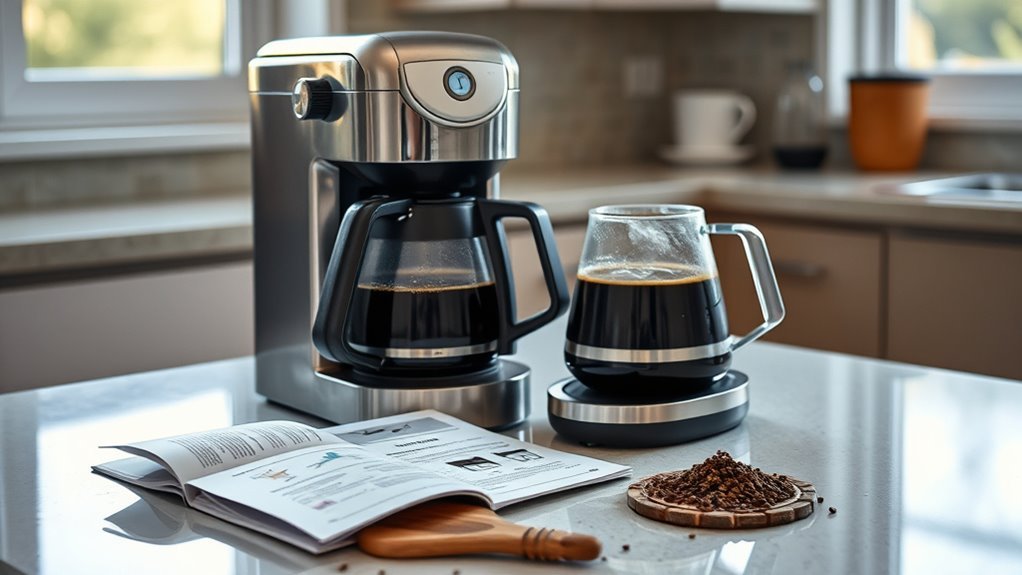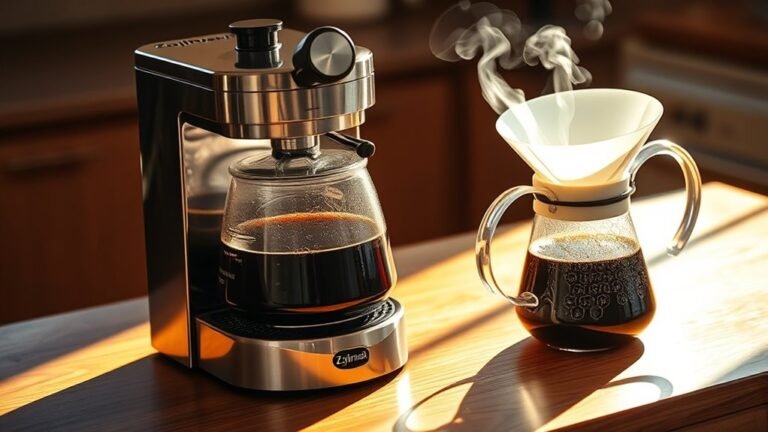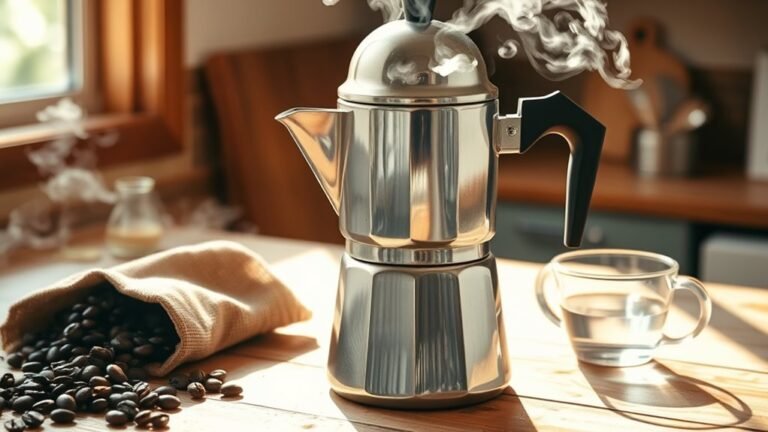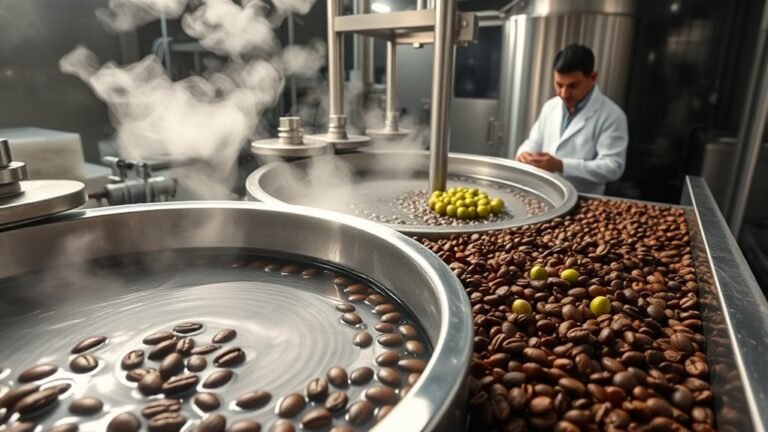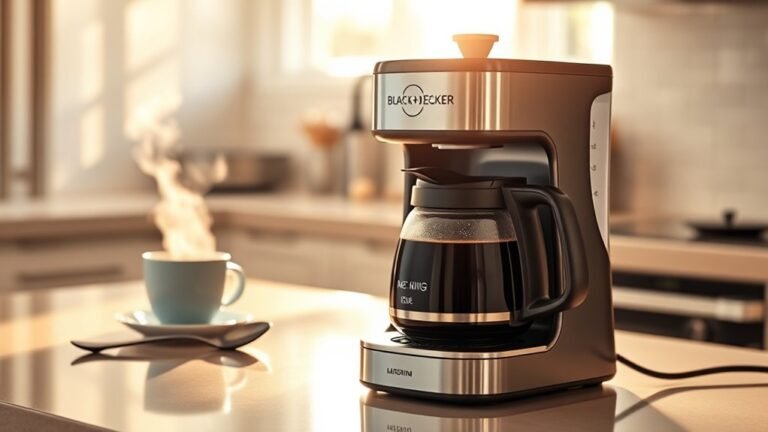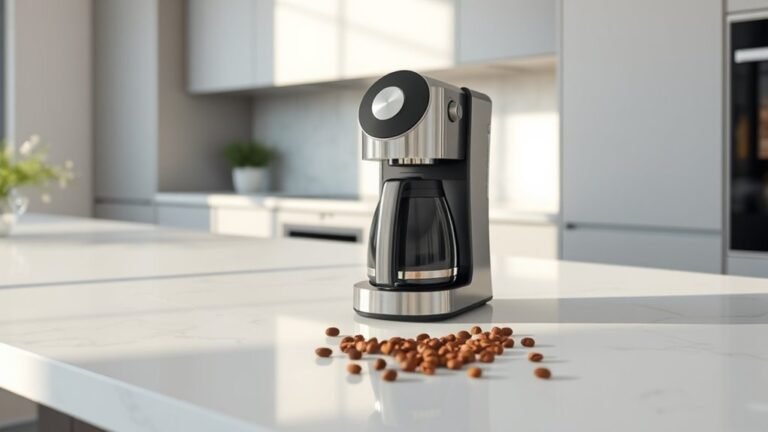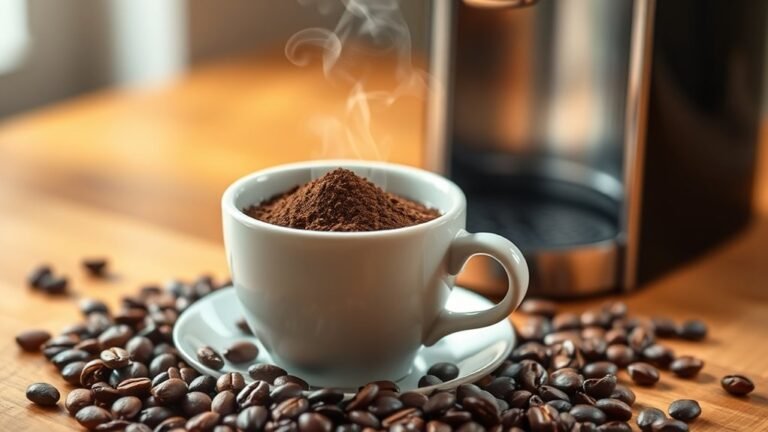The Pros and Cons of Automatic Drip Coffee Makers
If you want consistent, convenient coffee with precise temperature control, an automatic drip coffee maker is a solid choice. It automates water distribution and brewing time, saving you effort and ensuring balanced flavor. However, you might face limited control over brewing variables and need regular maintenance to avoid mineral buildup. Though easier than manual methods, flavor customization is less flexible, and repairs can be costly. Exploring further reveals how to optimize features and compare alternatives.
How Automatic Drip Coffee Makers Work
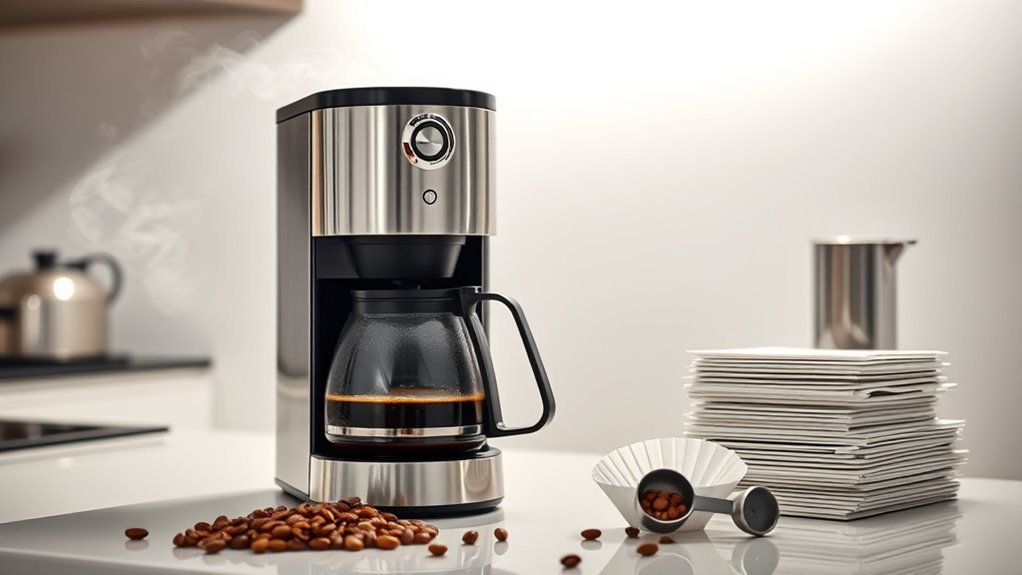
Although automatic drip coffee makers come in various designs, their core operation relies on a straightforward process: water is heated to an ideal temperature, then evenly distributed over ground coffee contained in a filter. You’ll find that the brewing process hinges on maintaining a precise water temperature, typically between 195°F and 205°F, to optimize extraction without scorching the grounds. Once heated, water is pumped through a showerhead to guarantee uniform saturation of the coffee bed, promoting consistent flavor release. The brewed coffee then drips into a carafe below, ready for consumption. Understanding these technical details gives you the freedom to appreciate how your machine balances temperature control and flow rate to deliver a reliable, well-extracted cup every time.
Advantages of Using Automatic Drip Coffee Makers
When you choose an automatic drip coffee maker, you benefit from precise temperature regulation and consistent water distribution that guarantee ideal extraction with minimal effort. This technology maximizes the convenience factor by automating brewing cycles, allowing you to enjoy freshly brewed coffee without manual intervention. Additionally, these machines offer remarkable cost efficiency by optimizing coffee grounds usage and reducing waste. Here are three key advantages:
- Consistent Quality: Automated controls maintain uniform brewing parameters, ensuring reliable taste every time.
- Time Savings: Programmable features let you schedule brewing in advance, freeing your mornings.
- Energy Efficiency: Many models include auto-shutoff functions, minimizing power consumption.
Common Drawbacks to Consider
While automatic drip coffee makers offer numerous benefits, there are several drawbacks you should be aware of before making a purchase. One primary concern is coffee quality; these machines often struggle to achieve the ideal extraction temperature and brew time, which can result in a weaker or bitter taste compared to manual methods. Additionally, maintenance issues can arise, as mineral buildup in internal components demands regular descaling to prevent clogs and guarantee consistent performance. The machine’s complexity may also lead to costly repairs if parts fail. Moreover, limited control over brewing variables restricts customization, potentially constraining your freedom to tailor the coffee precisely to your preferences. Understanding these limitations helps you weigh whether the convenience justifies potential compromises in taste and upkeep.
Features to Look for in an Automatic Drip Coffee Maker
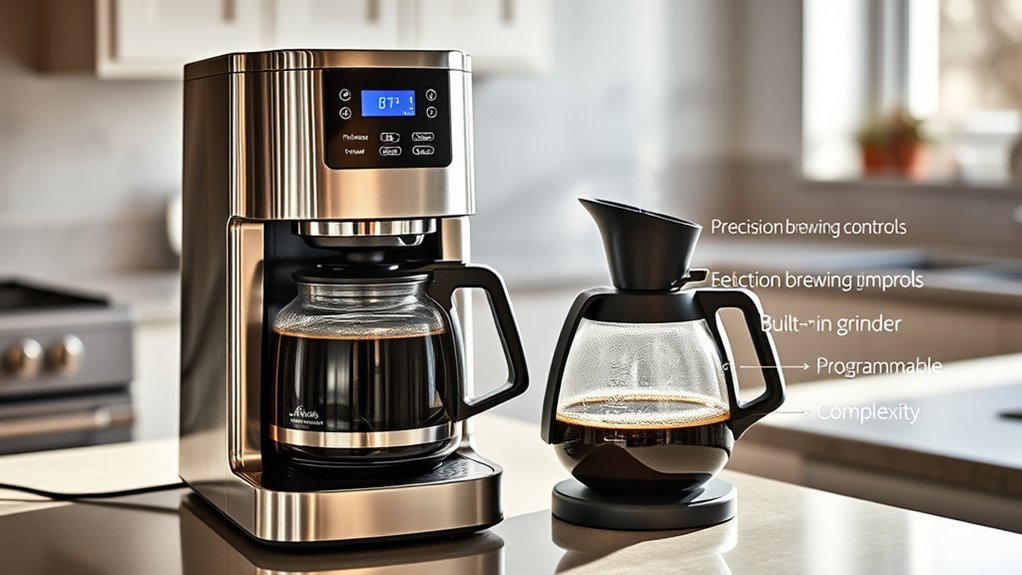
Since automatic drip coffee makers vary widely in design and functionality, knowing which features matter most can greatly impact your brewing experience. Prioritize models offering adjustable brew strength, allowing you to customize the coffee’s intensity to your preference. Programmable settings are essential for freedom in timing; they enable you to schedule brewing in advance, guaranteeing fresh coffee when you want it. Additionally, consider the quality of the water filtration system integrated into the machine, which influences flavor clarity and machine longevity.
- Adjustable brew strength control—tailor your coffee’s robustness.
- Programmable settings—set brew times for ultimate convenience.
- Built-in water filtration—improve taste and protect internal components.
Focusing on these features guarantees you select a machine that aligns precisely with your lifestyle and taste demands.
Comparing Automatic Drip Coffee Makers to Other Brewing Methods
When comparing automatic drip coffee makers to other brewing methods, you’ll notice significant differences in brewing speed, with drip machines typically offering faster extraction times. Flavor profiles also vary, as drip brewers tend to produce a more balanced but less intense cup compared to methods like espresso or pour-over. Additionally, ease of use is a key factor—automatic drip machines require minimal intervention, making them more convenient for consistent daily use.
Brewing Speed Comparison
Brewing speed is a critical factor for many coffee drinkers, especially those with tight schedules. Automatic drip coffee makers balance efficiency and quality by optimizing brewing temperature and coffee grind size, usually delivering a full pot within 5 to 10 minutes. Compared to other methods:
- Espresso Machines: Deliver shots within 30 seconds but require fine grind and pressure control.
- French Press: Takes about 4 minutes but depends on coarse grind and manual timing.
- Pour-Over: Offers control over brewing temperature and grind but demands 3 to 4 minutes per cup.
If you want freedom from manual brewing without sacrificing speed, automatic drip machines provide a reliable, consistent pace that suits most daily routines.
Flavor Profile Differences
Although automatic drip coffee makers offer convenience, their flavor extraction differs considerably from other brewing methods due to variations in water temperature stability, contact time, and grind consistency. You’ll notice that the brewing temperature in automatic machines often fluctuates, rarely hitting the ideal 195–205°F range needed to fully express the nuanced characteristics of your coffee origin. This can result in less vibrant acidity and muted aromatic compounds compared to pour-over or espresso methods, which allow greater control over these variables. Additionally, the standardized contact time in drip machines may under-extract or over-extract certain flavor notes, limiting your ability to tailor the cup’s profile. If you value highlighting specific origin attributes, manual methods typically provide a more refined and dynamic flavor experience than automatic drip coffee makers.
Ease of Use
Convenience stands as the foremost advantage of automatic drip coffee makers compared to other brewing methods. Their user friendly design and simple operation empower you to brew coffee without mastering complex techniques. Unlike manual pour-overs or espresso machines, these devices automate the brewing process, letting you focus on your day rather than coffee preparation.
Key aspects of ease of use include:
- Programmable Settings – Set brew time and strength in advance for consistent results.
- Minimal Manual Intervention – Add water and grounds, then start with a single button.
- Automated Cleaning Cycles – Maintain hygiene effortlessly without dismantling components.
This straightforward functionality grants you freedom from tedious steps, making automatic drip coffee makers ideal for those valuing efficiency without sacrificing quality.
Tips for Maintaining Your Automatic Drip Coffee Maker
To guarantee your automatic drip coffee maker performs at its best and lasts longer, you need to establish a regular maintenance routine. Employ effective cleaning techniques such as descaling with vinegar and regularly washing removable parts. Troubleshooting tips like checking for clogs and verifying the water reservoir is clean will prevent malfunctions and extend your machine’s lifespan.
| Maintenance Task | Frequency | Purpose |
|---|---|---|
| Descaling | Monthly | Remove mineral buildup |
| Cleaning Brew Basket | After each use | Prevent coffee residue buildup |
| Inspect Water Lines | Weekly | Avoid clogging and leaks |
| Check Electrical Components | Quarterly | Verify safety and functionality |
Frequently Asked Questions
Can Automatic Drip Coffee Makers Brew Tea or Other Beverages?
Ever wondered if your automatic drip coffee maker could double as a tea brewing device? While primarily designed for coffee, these machines offer some beverage versatility. You can brew tea by placing tea bags or loose tea in the filter basket, but temperature control isn’t precise, which might affect flavor. For freedom in beverage choices, consider models with adjustable settings or dedicated tea functions to guarantee ideal steeping without compromising taste.
Are Automatic Drip Coffee Makers Energy Efficient?
You’ll find automatic drip coffee makers generally have moderate energy consumption, balancing brewing speed with efficiency. They heat water quickly, minimizing idle time, which conserves electricity compared to slower methods. However, keep in mind that prolonged use of warming plates can increase energy use. If you value freedom and want to optimize efficiency, consider models with programmable timers or auto-shutoff features to reduce unnecessary power draw while still enjoying fast, reliable brewing.
How Long Do Automatic Drip Coffee Makers Typically Last?
You can expect an automatic drip coffee maker’s lifetime expectancy to range between 5 to 10 years, depending on build quality and usage frequency. To extend your machine’s life, follow maintenance tips like regular descaling, cleaning the filter basket, and avoiding hard water buildup. Staying proactive with upkeep guarantees consistent performance and lets you enjoy freedom from frequent replacements or repairs, maximizing your investment in reliable daily coffee brewing.
Do Automatic Drip Coffee Makers Require Special Coffee Filters?
Like choosing the right key for a complex lock, selecting the proper filter type is essential for your automatic drip coffee maker. Most models use standard basket or cone filters, compatible with various brewing methods. While some high-end machines demand specific filters, you generally don’t need special ones. Opt for paper or reusable metal filters based on your taste and environmental preferences, ensuring ideal extraction and the freedom to tailor your coffee experience.
Can Automatic Drip Coffee Makers Be Used With Hard Water?
You can use automatic drip coffee makers with hard water, but hard water effects like mineral buildup can impair performance and taste. To guarantee your machine runs smoothly, follow maintenance tips such as regularly descaling with vinegar or a commercial cleaner. This prevents clogging and extends your coffee maker’s lifespan. By staying proactive, you maintain freedom from frequent repairs and keep enjoying great coffee without sacrificing convenience or quality.
